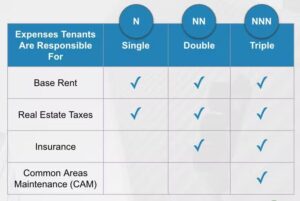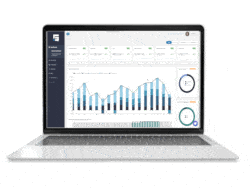It is important to understand pro-rata share when investing in commercial real estate since the majority of leases use this term. So, what is pro-rata share, or what does pro-rata share mean? Pro-rata refers to a method of splitting costs between tenants in a particular building. The pro-rata share defines the sum of money that every tenant pays towards shared costs. Some of these shared costs include maintenance fees, utilities, and property taxes. The landlord calculates each tenant’s share by comparing the square footage of their space to the total rentable area.
In this blog post, we will guide you on how to calculate pro-rata shares in commercial real estate. We will also include examples that show how this plays into how to calculate commercial property lease rates.
The pro-rata calculation is most frequently used in triple net leases (NNN), net net leases (NN), or net leases. These are leases where the tenant takes on additional fees on top of their base rent. The net charges include real estate taxes, insurance, and common area maintenance (CAM) expenses, based on whether the lease is N, NN, or NNN. The more nets included in the lease, the greater the expenses the tenant bears.
Pro-rata calculation plays a central role in dividing these costs among tenants of commercial property. The calculation allocates the costs proportionally by square footage occupancy for fair financial contributions toward shared expenses.

In the NNN lease, which includes CAM, the pro-rata share is each tenant’s portion of the building’s expenses. Most commonly, these maintain lobbies, hallways, parking lots, landscaping, and other communal facilities. For full transparency and trust between owners and tenants, include a full breakdown of all fees in the lease agreement, as this detail often plays a big role in how to calculate commercial lease rates accurately.
Property managers use pro-rata to help calculate the tenant’s share, provide transparency to tenants, and minimize arguments over shared financial responsibilities. It helps in controlling the cost of property effectively. It also helps maintain common areas in a good state. Pro-rata calculations usually provide tenants and landlords with freer use of resources since they share costs.
Types of Expenses Included in Pro-rata Calculations
Pro-rata share computations take into account a number of costs related to running and maintaining a business property. These costs could include:
Common Area Maintenance (CAM)
CAM charges are necessary payments that go toward financing the operation and upkeep of single property common areas. The scope of what is covered by CAM differs geographically and depending on the property type but may encompass such costs as:
- Landscaping
- Cleaning
- Security
- Parking lot maintenance
- Elevator maintenance
- Utilities like water, electricity, and gas that support these common areas
- Property maintenance
- Snow removal
- Permits
The specific expenses included in pro-rata calculations can vary by lease agreement. Some expenses may be included or excluded during lease negotiations for an individual tenant. Tenants and landlords should review the lease carefully to understand which expenses fall into the pro-rata share for each lease.
Gross-Up Provisions
When a building isn’t fully rented, landlords typically use a gross-up provision. They calculate expenses as if the property were, for example, 95% occupied. This approach accounts for costs like cleaning and utilities that don’t disappear when units sit empty. Gross-ups ensure tenants share expenses evenly without unfairly burdening those currently occupying the space.
Property Taxes
When calculating how much each tenant must pay, part of the costs can include property taxes for the entire commercial building. Taxes are also usually divided based on how much space each tenant occupies. For example, a tenant occupying 20% of the total space would be responsible for 20% of the property taxes.
Property Insurance
Property insurance is also a common element in pro-rata calculations to equitably share expenses among tenants. Insurance includes fire and liability, among others. The specifics may vary building by building. All tenants are collectively liable for maintaining core insurance coverages of the property.
Though the square-footage calculation for pro-rata shares may seem straightforward, it may involve unexpected nuances. Sometimes, there are differences in square footage calculations between individual leases and the overall building measurements. It is important to confirm all measurements are consistent before determining each pro-rata share.
Usable vs. Rentable Square Footage
Here’s a common area of dispute: usable vs. rentable square feet. Usable is the area you actually inhabit. Rentable is your share of common space, like hallways or lobbies. Leases typically charge you for rentable square feet, which makes your share larger. Always find out how your landlord is measuring, and whether they’re using BOMA standards, so you know what you’re paying for.
Calculate the Total Expense
Gather detailed information on all expenses associated with the property, including regular maintenance costs, property taxes, insurance premiums, and utility bills. Make sure to gather all the financial information. Then, calculate the total expenses for the property.
Use Calculation Methods
Landlords most often price by square footage, dividing the total property area among tenants based on the size of their leased space – a simple approach often searched as “pro rata how to calculate”.
This same process is often part of how to calculate commercial real estate rent since shared expenses are added on top of base rent.
First, determine the rentable square feet of space the tenant is leasing. Second, check the total rentable square feet of the building. Third, divide the rentable square feet by the total rentable square feet using the measure defined in the lease. This gives you the percentage of the total space occupied by the tenant.
Last, multiply the percentage of total space occupied by the tenant by 100. That will give you the tenant’s pro-rata share calculation.

Review and Update Regularly
Landlords should update and check the pro-rata share regularly. A tenant’s share changes if they reduce or increase their space. It can also change if a lease amendment requires the tenant to cover a specific expense at a higher rate.
For example:
- Tenants share the costs of maintaining and improving the property when fixes or upgrades are made.
- If the lease bases expenses on occupied square footage, exclude vacant spaces from the calculation.
It is a good idea to compare properties similar to yours or within your own portfolio to ensure your pro-rata share amounts align. Changing market conditions may also impact fees.
The area for pro-rata share calculations can be restricted in commercial real estate. This area may only include part of a building or the total square footage of several buildings.
This means that tenants in different spaces, say retail or office space, may have differently defined areas. Such differences may affect their pro-rata share calculations in particular ways. Therefore, it is important to take a close look at a detailed analysis of the lease in order to understand how to calculate the defined area for each tenant and property.
Maintaining precision when calculating the pro-rata share in commercial real estate is essential. Accurately estimating the pro-rata share ensures that each tenant pays a fair portion of operational costs.
Overpayments tighten the cash flow of a tenant, and reconciling and getting a reimbursement can be a hassle. Underpayments may also place tenants in a huge financial burden. If the landlords discover the difference later and demand compensation, the tenants are taken aback. This may not only impact one expense but perhaps several. In order to prevent this, it is best to check the lease and properly calculate the pro-rata figure beforehand.
Common Mistakes When Calculating Pro-Rata Share (and How to Avoid Them)
Even though calculating a pro-rata share seems simple, mistakes are common. Many people wonder how do I calculate pro rata, or how to calculate a pro rata share for their lease, but small errors can create big problems.
Some of the most common mistakes include:
- Using inconsistent measurements between usable and rentable square footage. Remember, what is a pro rata share depends on the lease’s definition of space.
- Forgetting to apply gross-up provisions when buildings are partially vacant. Without this, your pro rata calculated amount may unfairly burden some tenants.
- Mixing up what expenses are included. Not all costs, like structural improvements, fall under pro rata shares, so it’s essential to know define pro rata share clearly in your lease.
To avoid these pitfalls, always use a pro rata insurance calculator for insurance costs, a pro rata share calculator for CAM and taxes, and a pro rata calculation table to cross-check totals. When you know how to calculate pro rata share correctly, you avoid overpaying or underpaying, and it makes how to calculate commercial property lease rates much easier.
Difference Between Pro-Rata Share and Expense Stops in Commercial Leases
When reviewing a lease, it’s easy to confuse pro rata share with expense stops. Both affect how costs are divided, but they work differently. Pro rata shares are based on each tenant’s square footage — your portion of shared costs like maintenance, insurance, and taxes. Expense stops, on the other hand, set a limit on what the landlord covers. Any costs above that limit become the tenant’s responsibility.
Knowing what is a pro rata share and how to calculate commercial lease rates helps you understand the financial impact of these clauses. Using a pro rata share calculator or checking a pro rata calculation table ensures you pay only your fair share. Understanding how do you calculate a pro rata share also helps you see how expense stops can increase your total rent over time.
In short, pro rata shares determine how costs are split, while expense stops determine when tenants start paying those extra costs.
Exclusions and Caps on Expenses
Not everything can be charged to tenants. Exceptions and limits are where it comes in. Exceptions take expensive items like structural work or landlord arrears off your bill. Limits limit how much certain charges, like admin charges, can increase each year. Both give tenants more certainty and peace of mind — and are definitely worth negotiating when signing a lease.
How Pro-Rata Share Impacts CAM Reconciliation and Budget Forecasting
Understanding what is pro rata share isn’t just about splitting costs—it’s key for accurate CAM reconciliation and budget forecasting. Landlords and property managers often ask, “what does pro rata share mean in practice?” Essentially, your pro rata share determines your portion of shared expenses, including maintenance, utilities, insurance, and property taxes.
Disputes over bills usually arise when tenants don’t know how to figure out pro rata. This can be simplified by using a pro rata share calculator or a pro rata calculation table. With these tools, property managers can track each tenant’s pro rata of shares and ensure everyone pays their fair amount.
Properly understanding pro rata share meaning also helps in how to calculate commercial real estate rent or how to calculate commercial lease rates accurately. For example, if a tenant occupies 25% of the total rentable area, the formula for pro rata lets you determine exactly how much they owe for CAM, insurance, and taxes.
By regularly updating your pro rata calculation and using software tools, landlords can forecast budgets, avoid surprises at year-end, and keep tenants happy. Knowing how to figure pro rata share is just as important for tenants, who want transparency on how do you calculate commercial lease rates and other shared costs.
Calculate Your Pro-Rata with STRATAFOLIO
STRATAFOLIO effectively tracks your building’s size, the specific space occupied by each tenant, and any applicable rules regarding CAM charges. You can always be sure that the allocation of the operating expenses accurately reflects each tenant’s lease agreements.
Are you ready to streamline your CAM charge management and improve your pro-rata calculations? Learn why neglecting CAM reconciliation can have a devastating financial impact on income generation for both landlords and tenants in commercial properties.
Schedule a demo to use our CAM 1-click functionality. This allows users to complete their CAM reconciliations easily and efficiently. It is based on data from QuickBooks, so you don’t have to do any manual calculation. Don’t miss the opportunity to enhance your commercial property management experience!




